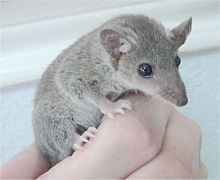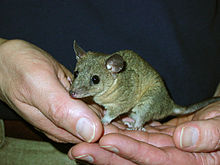- Gray short-tailed opossum
-
Gray short-tailed opossum[1] 
Conservation status Scientific classification Kingdom: Animalia Phylum: Chordata Class: Mammalia Order: Didelphimorphia Family: Didelphidae Subfamily: Didelphinae Genus: Monodelphis Species: M. domestica Binomial name Monodelphis domestica
(Wagner, 1842)
Gray Short-tailed Opossum range The gray short-tailed opossum (Monodelphis domestica) is a small member of the Didelphidae family of opossums. It was the first marsupial to have its genome sequenced. It is naturally found in arboreal habitats in Bolivia, Brazil and Paraguay. The opossum is used as a research model in science,[3] and is also frequently found in the exotic pet trade. It is also known as the Brazilian opossum, rainforest opossum and in a research setting the laboratory opossum.
Laboratory opossum
The gray short-tailed opossum possesses several features that make in ideal research model, particularly in studies of marsupials, as well as the immunological and developmental research on mammalian systems. It breeds relatively easily in laboratory settings, and neonates are exposed and can be readily accessed because, unlike other marsupial species, female opossums lack a pouch: neonates simply cling to the teats. Opossums are born at a stage that is approximately equivalent to 13- to 15-day-old fetal rats or 40-day-old human embryos. Like other marsupials, the inadequacies of the neonate's immune system function make it an ideal model for both transplant and cancer research, as well as general investigations into immune system development.[4] Its genome was sequenced and a working draft published in May 2007:[5] the decoding work, directed by MIT and Harvard, reveals the opossum to have between 18,000 and 20,000 protein-coding genes.
References
- ^ Gardner, Alfred (16 November 2005). Wilson, Don E., and Reeder, DeeAnn M., eds. ed. Mammal Species of the World (3rd ed.). Baltimore: Johns Hopkins University Press, 2 vols. (2142 pp.). pp. 14. ISBN 978-0-8018-8221-0. OCLC 62265494. http://www.bucknell.edu/msw3.
- ^ Bonvicino, C. & Astua de Moraes, D. (2008). Monodelphis domestica. In: IUCN 2008. IUCN Red List of Threatened Species. Downloaded on 28 December 2008. Database entry includes justification for why this species is of least concern
- ^ "Extraordinary Resources: The Laboratory Opossum". SFBR. http://www.sfbr.org/pages/about_resources5.php. Retrieved 2007-04-13.
- ^ Wang Z; Hubbard GB, Pathak S, and VandeBerg JL (October 1, 2003). "In vivo opossum xenograft model for cancer research". Cancer Research 63 (19): 6121–6124. PMID 14559788. http://cancerres.aacrjournals.org/cgi/content/full/63/19/6121.
- ^ Mikkelsen TJ et al. (May 2007). "Genome of the marsupial Monodelphis domestica reveals innovation in non-coding sequences". Nature 447 (7141): 167–177. doi:10.1038/nature05805. PMID 17495919. http://www.nature.com/nature/journal/v447/n7141/full/nature05805.html.
External links
 Media related to Monodelphis domestica at Wikimedia Commons
Media related to Monodelphis domestica at Wikimedia Commons- Know Your STO (Short-tailed Opossums), pet care website by Molly Kalafut
Categories:- IUCN Red List least concern species
- Opossums
- Model organisms
- Mammals of South America
- Mammals of Brazil
- Mammals of Paraguay
- Sequenced genomes
Wikimedia Foundation. 2010.


